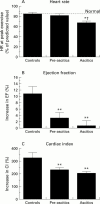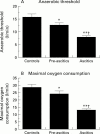The cardiac response to exercise in cirrhosis
- PMID: 11454805
- PMCID: PMC1728392
- DOI: 10.1136/gut.49.2.268
The cardiac response to exercise in cirrhosis
Abstract
Background: Impaired exercise capacity and oxygen consumption are common in cirrhosis.
Aim: To explore the relationship between possible myocardial dysfunction and exercise tolerance in cirrhosis.
Methods: Cardiac responses to exercise, using radionuclide angiography and graded upright cycle ergometry with oxygen consumption, were assessed before and after exercise in 39 cirrhotics patients and compared with 12 age and sex matched healthy volunteers. Baseline cardiac chamber dimensions and wall thickness, ejection fraction, and diastolic function were measured using two dimensional echocardiography is all subjects.
Results: Baseline diastolic dysfunction with prolonged isovolumic relaxation times (p=0.02), left atrial enlargement, and left ventricular wall thickening were present in all cirrhotics (p=0.02), despite increased mean ejection fraction. With graded exercise, cirrhotics achieved 71 (4)% (p=0.03) (pre-ascitics) and 46 (3)% (p<0.001) (ascitics) of predicted work loads, respectively, without significant increases in ejection fraction. The smaller absolute and percentage increases in cardiac output (p=0.003) in the cirrhotics were associated with significantly reduced oxygen consumption (p=0.003) and anaerobic threshold (p<0.001), and correlated significantly with work and metabolic parameters.
Conclusions: Impaired exercise capacity in cirrhosis is associated with myocardial thickening and ventricular stiffness leading to decreased diastolic function, inotropic and chronotropic incompetence under conditions of stress, with metabolic consequences. This picture is compatible with the condition now known as cirrhotic cardiomyopathy.
Figures


Comment in
-
Cardiac response to exercise in cirrhosis.Gut. 2002 Nov;51(5):755; author reply 755. doi: 10.1136/gut.51.5.755-a. Gut. 2002. PMID: 12377820 Free PMC article. No abstract available.
Similar articles
-
Modification of cardiac function in cirrhotic patients with and without ascites.Am J Gastroenterol. 2000 Nov;95(11):3200-5. doi: 10.1111/j.1572-0241.2000.03252.x. Am J Gastroenterol. 2000. PMID: 11095342
-
Allograft diastolic dysfunction and chronotropic incompetence limit cardiac output response to exercise two to six years after heart transplantation.J Heart Lung Transplant. 1995 Jan-Feb;14(1 Pt 1):11-22. J Heart Lung Transplant. 1995. PMID: 7727459
-
Evidence of functional and structural cardiac abnormalities in cirrhotic patients with and without ascites.Hepatology. 1997 Nov;26(5):1131-7. doi: 10.1002/hep.510260507. Hepatology. 1997. PMID: 9362352
-
Response to exercise in patients with liver cirrhosis: implications for liver transplantation.Dig Liver Dis. 2013 May;45(5):362-6. doi: 10.1016/j.dld.2012.09.022. Epub 2012 Nov 6. Dig Liver Dis. 2013. PMID: 23137795 Review.
-
Left ventricular function assessment in cirrhosis: Current methods and future directions.World J Gastroenterol. 2016 Jan 7;22(1):112-25. doi: 10.3748/wjg.v22.i1.112. World J Gastroenterol. 2016. PMID: 26755864 Free PMC article. Review.
Cited by
-
Surgery in a patient with liver disease.J Clin Exp Hepatol. 2012 Sep;2(3):238-46. doi: 10.1016/j.jceh.2012.05.003. Epub 2012 Sep 21. J Clin Exp Hepatol. 2012. PMID: 25755440 Free PMC article. Review.
-
Cirrhotic Cardiomyopathy: The Interplay Between Liver and Heart.Cureus. 2022 Aug 13;14(8):e27969. doi: 10.7759/cureus.27969. eCollection 2022 Aug. Cureus. 2022. PMID: 36120195 Free PMC article. Review.
-
The Contemporary Role of Speckle Tracking Echocardiography in Cirrhotic Cardiomyopathy.Life (Basel). 2024 Jan 25;14(2):179. doi: 10.3390/life14020179. Life (Basel). 2024. PMID: 38398688 Free PMC article. Review.
-
A semi-mechanistic model to predict the effects of liver cirrhosis on drug clearance.Clin Pharmacokinet. 2010 Mar;49(3):189-206. doi: 10.2165/11318160-000000000-00000. Clin Pharmacokinet. 2010. PMID: 20170207
-
Prolonged QT Interval in Cirrhosis: Twisting Time?Gut Liver. 2022 Nov 15;16(6):849-860. doi: 10.5009/gnl210537. Epub 2022 Jul 22. Gut Liver. 2022. PMID: 35864808 Free PMC article. Review.
References
Publication types
MeSH terms
Substances
LinkOut - more resources
Full Text Sources
Medical
